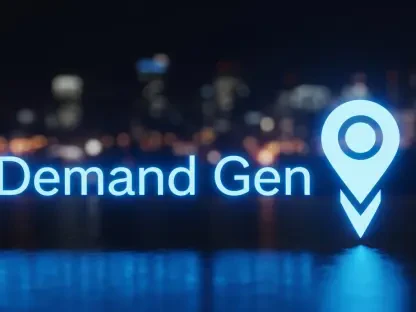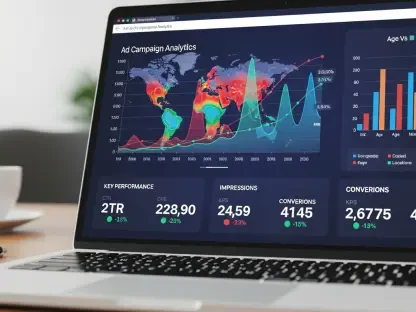Navigating the Digital PR Landscape
In an era where digital presence defines brand success, the realm of digital public relations and search engine optimization faces unprecedented turbulence, with industry giants like Google reshaping the playing field overnight. A staggering reality emerges as recent changes reveal that up to 50% of search impressions on some websites might have been artificially inflated by bots, shaking the foundation of how digital impact is measured. This seismic shift, coupled with groundbreaking advancements in browser technology, sets the stage for a critical examination of how businesses must adapt to maintain visibility and relevance in an ever-evolving online ecosystem.
The scope of digital PR extends across a vast network of tools, platforms, and strategies, with key players like Google driving innovation and, at times, disruption. Staying abreast of rapid technological advancements and policy changes is no longer optional but essential for survival in this competitive space. The focus here narrows to two pivotal developments: Google’s restrictive search result policies sparking an SEO crisis and Chrome’s leap into AI-driven features promising a new frontier for user engagement.
This analysis aims to unpack these transformative trends, exploring their immediate impacts and long-term implications for digital PR professionals. From operational challenges to emerging opportunities, the discussion will navigate through the complexities of adapting to a landscape where data reliability and personalization are at the forefront of strategic planning.
Key Developments Shaking Up Digital PR and SEO
Google’s Search Result Restriction and SEO Tool Fallout
Google’s recent policy shift to limit search result visibility to the top 10 positions, by removing the “&num=100” parameter, has sent shockwaves through the SEO community. This change, altering how data is accessed, has directly impacted the functionality of widely used tools such as SEMrush and Ahrefs. The restriction means that comprehensive ranking insights beyond the most prominent results are now harder to obtain, fundamentally changing the scope of competitive analysis.
The operational fallout for these SEO platforms is significant, with costs for sourcing ranking data reportedly increasing up to tenfold due to the need for alternative data collection methods. Beyond financial strain, the incomplete datasets resulting from this limitation hinder the ability to provide accurate insights. For many businesses relying on these tools, the challenge lies in interpreting partial information to make informed decisions about online strategies.
Digital PR professionals face a ripple effect from this disruption, as Google Search Console data indicates drops in search impressions by as much as 50% for certain websites. This decline raises critical questions about the validity of historical data, with speculation that past impression spikes may have been driven by bot activity rather than genuine user interest. The uncertainty now forces a reevaluation of how campaign success is measured and reported in this altered environment.
Chrome’s AI Innovations and Market Implications
On another front, Google Chrome has introduced transformative AI features, including “Gemini in Chrome,” an assistant capable of operating across multiple tabs, an AI Mode search bar button for direct queries, and enhanced security protocols for its 3.45 billion users. These updates mark a significant step toward integrating artificial intelligence into everyday browsing, offering capabilities that extend beyond simple searches to more complex, context-aware interactions.
This shift toward AI-driven experiences signals a future where personalization becomes the cornerstone of online engagement, with potential for agentic capabilities that anticipate user needs based on historical data. The implications for digital PR are profound, as campaigns must now cater to highly individualized user journeys, moving away from broad, one-size-fits-all approaches to content delivery.
Market trends underscore the urgency of adapting to these advancements, with early data suggesting rapid user adoption of Chrome’s new features. Projections indicate that AI integration in browsers could see exponential growth over the next few years, with estimates pointing to a substantial increase in personalized content consumption by 2027. For PR strategies, this necessitates a deeper investment in audience segmentation and tailored messaging to align with evolving user expectations.
Challenges in Adapting to the SEO Crisis and Data Disruptions
The immediate hurdles for digital PR and SEO experts stem from the unreliability of traditional tools following Google’s search result restrictions. With incomplete data becoming the norm, professionals struggle to assess the true reach and impact of their efforts. This disruption particularly affects metrics like search impressions, long considered a benchmark for visibility, now rendered questionable in their accuracy.
Beyond tool limitations, the industry faces a broader challenge in redefining success beyond vanity metrics. The focus must shift to alternative tracking methods, such as user engagement rates or conversion analytics, which offer more tangible insights into campaign performance. Exploring these new avenues requires both technological innovation and a cultural shift in how results are prioritized and communicated to stakeholders.
Adding to the complexity is the looming uncertainty around historical data integrity, as past reports may have been skewed by artificial traffic. This realization calls for greater transparency in reporting outcomes, with a need to annotate previous findings to reflect potential inaccuracies. Addressing these issues head-on is crucial for maintaining trust and credibility in an industry already grappling with rapid change.
Regulatory and Ethical Considerations in the Digital Space
The regulatory environment surrounding digital PR is becoming increasingly intricate, with legal disputes highlighting tensions between technology providers and content creators. A notable case involves Penske Media’s lawsuit against Google over AI Overviews, raising questions about fair use and compensation in the age of AI-generated content summaries. Such conflicts underscore the need for clear guidelines as digital practices evolve.
Emerging models, like Microsoft’s pilot content marketplace, offer potential solutions by creating frameworks for compensating publishers whose content fuels AI search results. If successful, these initiatives could reshape industry standards, balancing the interests of tech giants with those of original content producers. Monitoring these developments is vital for anticipating shifts in how digital assets are valued and protected.
Ethical considerations also play a pivotal role, particularly around data privacy and AI search practices. Compliance with global standards is non-negotiable, as mishandling user information can erode trust and invite regulatory scrutiny. Strategically, this means embedding ethical principles into campaign design, ensuring that personalization efforts respect user boundaries while maintaining effectiveness in a competitive digital arena.
Future Horizons: Personalization and Industry Evolution
Looking ahead, the trajectory of digital PR points firmly toward hyper-personalization, fueled by Chrome’s AI capabilities that tailor online experiences to individual preferences. This trend demands a departure from generic outreach, pushing brands to craft messages that resonate on a deeply personal level. Leveraging data insights to understand user behavior will be the cornerstone of future success.
Emerging platforms like Google Discover add another layer of opportunity, with features such as follow buttons and upcoming social media integration enhancing audience engagement. These tools amplify the importance of precise targeting, as content must align with specific interests to capture attention in crowded digital spaces. Capitalizing on these platforms requires agility and a commitment to continuous learning.
Potential disruptors, including ongoing spam updates and fluctuating global economic conditions, also loom on the horizon, challenging the stability of current strategies. Yet, growth areas abound in audience-centric approaches and innovative tools designed to navigate these uncertainties. Embracing adaptability and investing in technologies that prioritize user connection will position digital PR for sustained relevance amid constant evolution.
Conclusion: Adapting to a Transformative Digital Era
Reflecting on the insights gathered, the dual forces of an SEO crisis triggered by Google’s search restrictions and the forward momentum of Chrome’s AI innovations have underscored a pivotal moment for digital PR. The challenges of unreliable data and the push for personalized engagement have demanded a strategic overhaul, compelling professionals to rethink established practices.
Moving forward, actionable steps emerge as clear priorities: focusing on meaningful metrics over superficial data points has proven essential for credible reporting. Investing in detailed audience analysis has also become non-negotiable, ensuring campaigns resonate with specific user needs in an AI-driven landscape. Staying vigilant about regulatory changes offers a safeguard against unforeseen compliance risks.
Ultimately, the path ahead invites a mindset of innovation, where embracing change becomes synonymous with opportunity. By proactively addressing these transformative shifts, digital PR professionals lay the groundwork for not just survival, but thriving growth in a dynamic era, setting a precedent for resilience and forward-thinking strategy.









